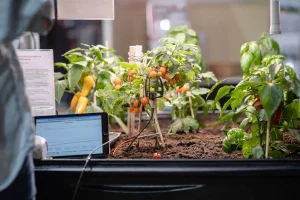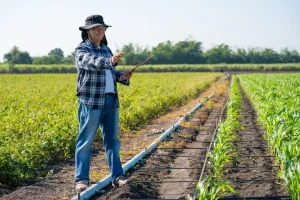The question of what is an Automatic Irrigation System is important in terms of modern agricultural practices. Therefore, they are systems that perform the irrigation process without human intervention. It also provides efficiency by working with sensors and timers. In this way, water waste is minimized. Also, irrigation meets the plant’s specific needs. In this case, both energy and water are saved. It also reduces the need for labor in large agricultural areas. Therefore, production becomes easier while costs decrease. In addition, it can work integrated with drip, sprinkler and underground irrigation systems. In this way, it adapts to different land types. Furthermore, instant intervention is possible thanks to systems that can be controlled remotely. In this case, climate changes can be responded to quickly. In addition, water balance is maintained by monitoring soil moisture levels.
Table of Contents
- Irrigation Methods
- Sprinkler Irrigation System
- Drip Irrigation System
- How Does an Automatic Irrigation System Work?
- Advantages of Using Automatic Irrigation System
- Conclusion
- Frequently Asked Questions
Irrigation Methods
Irrigation methods are the general name of techniques that ensure efficient use of water in agriculture. Therefore, it is important to choose the method according to the climate of the region and the type of plant. In addition, surface irrigation is one of the oldest and most widely used systems. In this way, water is distributed to the field through open channels. Also, sprinkler irrigation mimics rainfall, delivering water in droplets. Drip irrigation targets the root zone, minimizing loss. Furthermore, underground systems supply water below soil, preventing evaporation. In addition, flood irrigation is carried out by letting the water flow freely. In this case, water control can be difficult. With modern automated systems, irrigation becomes programmable, reducing labor needs. Also, sensor systems irrigate based on soil moisture.

Sprinkler Irrigation System
Sprinkler Irrigation System is a method that delivers water to plants in the form of artificial rainfall. Therefore, it creates a natural rain effect and moisturizes the soil in a balanced way. In addition, pressurized water is sprayed with the help of pipes and sprinklers. In this way, large areas can be irrigated in a short time. It also provides efficient irrigation on sloping and hilly terrain. In this case, it is possible for the water to reach every point equally. In addition, the portability of the system offers ease of use. Therefore, it suits various areas and saves water with timed irrigation. In this way, energy and water costs drop. Also, by moistening leaves, it cools and reduces plant stress. It prevents soil hardening, supporting root growth. Therefore, efficient plant development is achieved.

Drip Irrigation System
Drip Irrigation System is a method that allows water to be applied directly to the plant root zone. Therefore, it is very effective in terms of efficient use of water. In addition, water is delivered slowly via pipes and drippers. In this way, evaporation and runoff are minimized. Also, controlled watering preserves soil structure. In this case, erosion risk drops significantly. Moreover, dry leaves reduce disease risk. Therefore, plant health is maintained with equal water distribution. In this way, homogeneous growth occurs. Additionally, combining fertilization increases efficiency. In this case, labor needs decrease. Moreover, automation further simplifies the process.

How Does an Automatic Irrigation System Work?
The question How Does an Automatic Irrigation System Work is frequently asked in technology-supported agriculture applications. Therefore, the basic components of the system should be well understood. Also, automatic irrigation works with a timer and control unit. In this way, water is provided at specified hours. Furthermore, the system can be integrated with drip or sprinkler irrigation. This facilitates use in different areas. In addition, water requirement is measured with soil moisture sensors. Therefore, irrigation is only applied when necessary. Furthermore, the control panel can be managed manually or remotely. In this way, the farmer can intervene instantly. Furthermore, the valve and pump systems start the water flow automatically. In this case, the need for manpower is reduced. In addition, the system can also run on solar energy. Therefore, energy savings are achieved. Furthermore, irrigation time and flow rate can be adjusted.

Advantages of Using Automatic Irrigation System
Advantages of Using Automatic Irrigation System It benefits the producer in many ways. Therefore, it is widely preferred in modern agriculture. It also ensures that water is delivered only when it is needed. In this way, water wastage is significantly reduced. In addition, plants are watered regularly and evenly. This increases productivity and reduces the risk of stress. Furthermore, the system works automatically, with no manual intervention required. Therefore, labor costs are reduced. In addition, data-based irrigation can be done with timers and sensors. In this way, rapid adaptation to climate changes is ensured. Furthermore, soil moisture is kept under control. In this case, root development is supported and plant health is improved. Furthermore, the systems can be managed remotely. Therefore, control and intervention becomes easier. Furthermore, fertilization can be integrated with the system. In this way, nutrients are delivered directly to the root.

Conclusion
The question of what is an Automatic Irrigation System is the basis of productivity and sustainability-oriented agriculture. Therefore, it is a smart solution that ensures controlled and timely delivery of water. In addition, thanks to the system, both labor is saved and resource use is optimized. What is an Automatic Irrigation System is also the starting point of environmentally friendly production processes. In this way, soil fertility is preserved, plant development progresses in a balanced manner and producer costs are reduced.
Frequently Asked Questions
What are irrigation methods? Irrigation methods are classified as surface irrigation, sprinkler, drip and automatic systems.
How does a sprinkler irrigation system work? Pressurized water is sprayed from sprinkler heads like rain and delivered to the plants.
In which areas is sprinkler irrigation used? It is preferred in large and sloping lands, vegetable-fruit production and lawn areas.
What is the advantage of sprinkler irrigation system? It provides a natural rainfall effect, provides homogeneous irrigation and protects the soil surface.
What is drip irrigation system? Water is dripped directly onto the plant roots with low pressure.
What is the biggest benefit of drip irrigation? It prevents water waste, provides the plant with the required amount of water and reduces evaporation.
How does an automatic irrigation system work? With the help of timers and sensors, the irrigation process is started automatically.
In which areas are automatic irrigation systems used? It is used in many places such as agricultural lands, greenhouses, landscaping areas and lawns.
What are the advantages of using an automatic irrigation system? It saves water and energy, reduces labor costs and increases productivity.
Which irrigation system is more efficient? Drip and automatic systems are the most efficient methods in terms of water saving and efficiency.

 English
English
 Türkçe
Türkçe
 Ελληνικά
Ελληνικά
 Deutsch
Deutsch
 ქართული
ქართული
 العربية
العربية








